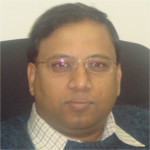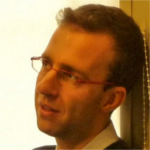-
T1 - Sensor Cloud: A Cloud of Wireless Sensors
Sanjay Kumar Madria - Missouri University of Science and Technology, USA
Sanjay Kumar Madria
Missouri University of Science and Technology, USAMonday, December 12 – 09:00
Department of Sociology and Social Research - Room 10Traditional model of computing with wireless sensors imposes restrictions on how efficiently wireless devices can be used due to resource constraints. Newer models for interacting with wireless sensors such Sensor Cloud and Internet of Things and aim to overcome these restrictions. In this talk, I will discuss sensor cloud and IoT architectures which enables different wireless networks consisting of sensors and other mobile devices, spread in a huge geographical area to connect together and be used by multiple users at the same time on demand basis. I will further discuss how virtual sensors assist in creating a multi user environment on top of resource constrained physical wireless devices and can help in supporting multiple applications on-demand basis. I will then present some security issues and provide overview of the solutions to the problems. I will discuss energy efficient privacy and integrity preserving data aggregation algorithm, attribute-based access control and risk assessment in sensor cloud applications. The topics covered will be:
- Cloud of Sensors – Architectures
- Virtualization in Sensor Cloud
- On Demand Sensor Scheduling and Routing in Sensor Cloud
- Data Management in Sensor Cloud
- Security, Privacy and Risk Issues in Sensor Cloud
- Sensor Cloud and IoT Systems: Applications
Tutorial slides along with copies of the some of the papers will be provided.
Who Can Attend: This tutorial is designed for academicians and researchers working in the area of IoT, sensor networks, sensor cloud, security and privacy. It is to help sensor cloud designers, project and technical managers, people involved in planning, designing, developing, implementing and administrating sensor cloud applications. It is also for students of computer and information science who are pursuing or planning to pursue a higher research degree.
Speaker Bio
 Sanjay Kumar Madria is a full professor in the Department of Computer Science at the Missouri University of Science and Technology (formerly, University of Missouri-Rolla, USA). He has published over 225 Journal and conference papers in the areas of mobile data management, Sensor computing, and cyber security and trust management. He won five best papers awards from conferences such as IEEE SRDS 2015, IEEE MDM 2011 and IEEE MDM 2012. His research is supported by several grants from federal sources such as NSF, DOE, AFRL, ARL, ARO, NIST and industries like Boeing, etc. He has also been awarded JSPS (Japanese Society for Promotion of Science) visiting scientist fellowship in 2006 and ASEE (American Society of Engineering Education) fellowship at AFRL from 2008 to 2016. In 2012-13, he was awarded NRC Fellowship by National Academies. He has received faculty excellence research awards in 2007, 2009, 2011, 2013 and 2015 from his university for excellence in research. He served as an IEEE Distinguished Speaker, and currently, he is an ACM Distinguished Speaker, and IEEE Senior Member and Golden Core awardee.
Sanjay Kumar Madria is a full professor in the Department of Computer Science at the Missouri University of Science and Technology (formerly, University of Missouri-Rolla, USA). He has published over 225 Journal and conference papers in the areas of mobile data management, Sensor computing, and cyber security and trust management. He won five best papers awards from conferences such as IEEE SRDS 2015, IEEE MDM 2011 and IEEE MDM 2012. His research is supported by several grants from federal sources such as NSF, DOE, AFRL, ARL, ARO, NIST and industries like Boeing, etc. He has also been awarded JSPS (Japanese Society for Promotion of Science) visiting scientist fellowship in 2006 and ASEE (American Society of Engineering Education) fellowship at AFRL from 2008 to 2016. In 2012-13, he was awarded NRC Fellowship by National Academies. He has received faculty excellence research awards in 2007, 2009, 2011, 2013 and 2015 from his university for excellence in research. He served as an IEEE Distinguished Speaker, and currently, he is an ACM Distinguished Speaker, and IEEE Senior Member and Golden Core awardee.
-
T2 - Middleware for Indoor Location-Based Services
Daniele Miorandi - U-Hopper, Italy
Daniele Miorandi
U-Hopper, ItalyMonday, December 12 – 13:45
Department of Sociology and Social Research - Room 10Indoor location-based services (LBSs) make use of the knowledge of the position of entities (people and assets) in indoor spaces to deliver value to their users. Examples range from navigation in shopping malls to tracking portable medical equipment in hospital all the way to monitoring the position of personnel on offshore rigs. Thanks to recent progresses in technology (indoor positioning systems becoming accurate and economically viable) and standardization (in terms of interfaces and representation of indoor spaces) we are now reaching a tipping point. The market for indoor LBSs is already at $1+B, and is growing at a CAGR of 36%, hence the need is real and large. The lack of a widely available set of middleware components reusable across domains represents both a challenge (for companies entering the field) as well as an opportunity (for researchers and practitioners). The tutorial will introduce the fundamental notions of indoor LBSs, present the most trendy application domains and use cases, discuss the state-of-the-art of key enabling technologies and, finally, include a hands-on session in which participants will receive training on how to use common open source enablers to build indoor LBS prototypes.
Speaker Bio
 Daniele Miorandi is Executive VP R&D at U-Hopper, where he leads R&D&I activities of the company, and Chief Research Officer at Thinkinside (Thinkin.io), where he leads the design of innovative algorithmic solutions powering indoor location-based services. He holds a PhD in Telecommunications Engineering from University of Padova, and before joining industry has worked in various research positions at INRIA, CNR and CREATE-NET. He has published 130+ articles and papers, and has an h-index of 25. He is listed as inventor in four patents. His research interests include big data analytics solutions, design of game theory-based distributed protocols and social collective intelligence solutions. He has extensive experience in the management of cooperative R&D projects, having led a number of FP6/FP7/H2020 projects and initiatives.
Daniele Miorandi is Executive VP R&D at U-Hopper, where he leads R&D&I activities of the company, and Chief Research Officer at Thinkinside (Thinkin.io), where he leads the design of innovative algorithmic solutions powering indoor location-based services. He holds a PhD in Telecommunications Engineering from University of Padova, and before joining industry has worked in various research positions at INRIA, CNR and CREATE-NET. He has published 130+ articles and papers, and has an h-index of 25. He is listed as inventor in four patents. His research interests include big data analytics solutions, design of game theory-based distributed protocols and social collective intelligence solutions. He has extensive experience in the management of cooperative R&D projects, having led a number of FP6/FP7/H2020 projects and initiatives.
-
T3 - Gossip as a framework
Alberto Montresor - University of Trento, Italy
Alberto Montresor
University of Trento, ItalyTuesday, December 13 – 09:00
Department of Sociology and Social Research - Room 10Gossip and epidemic protocols have been introduced to disseminate information to a large number of nodes. Since then, the gossip paradigm has expanded its applicability to a large number of diverse scenarios: maintaining up-to-date membership information about the state of large-scale and dynamic P2P network, implementing garbage collection, computing aggregate information, self-organizing complex overlay topologies, and allocating resources are just a few examples. Gossip protocols are the foundation of several decentralized streaming and file-sharing protocols, are included in modern NoSQL architectures and have found their way inside cloud datacenters.
In this tutorial, we will outline a framework for the development of gossip protocols and we will show how this framework can be customized to solve the most diverse problems, including aggregation, topology management, and most-frequent item identification, without forgetting the original goal – message dissemination. We will introduce modern protocols for flow control and we will conclude by briefly analyzing recent developments in the field of byzantine gossip protocol.
While gossip protocols have been applied in several settings, the associated literature is scattered and a comprehensive analysis of the potentialities of the gossip paradigm is missing. This tutorial is aimed at filling this void.
Speaker Bio
 Alberto Montresor received a M.Sc. degree in Computer Science from the University of Bologna in 1995, and a Ph.D. from the same university in 2000. After having served as post-doc and research assistant at the University of Bologna for five years, he joined the University of Trento in 2005 as associate professor. He has authored more than 80 papers on large-scale distributed systems, cloud computing and P2P networks; he also co-authored a textbook on algorithms and data structures. He served as general chair and program chair for several conferences (DOA, DAIS, SASO, P2P) and steering committe chair of the IEEE Conference on Peer-to-Peer Computing.
Alberto Montresor received a M.Sc. degree in Computer Science from the University of Bologna in 1995, and a Ph.D. from the same university in 2000. After having served as post-doc and research assistant at the University of Bologna for five years, he joined the University of Trento in 2005 as associate professor. He has authored more than 80 papers on large-scale distributed systems, cloud computing and P2P networks; he also co-authored a textbook on algorithms and data structures. He served as general chair and program chair for several conferences (DOA, DAIS, SASO, P2P) and steering committe chair of the IEEE Conference on Peer-to-Peer Computing.








